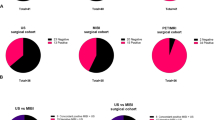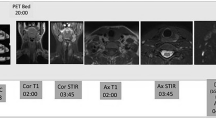Abstract
Purpose
Preoperative localization of a parathyroid adenoma is usually obtained by the combination of ultrasound and scintigraphy with technetium-99m methoxyisobutylisonitrile. We evaluated the role of F18-fluorocholine in neck positron emission tomography/magnetic resonance imaging as a novel tool for localizing parathyroid adenomas.
Methods
Patients with primary hyperparathyroidism were recruited from February 2016 to August 2017 and F18-fluorocholine positron emission tomography/magnetic resonance imaging was performed to localize the parathyroid adenoma prior to surgery. We compared sensitivity and accuracy of this modality with ultrasound and technetium-99m methoxyisobutylisonitrile scintigraphy using the verified location of the diseased parathyroid as found in surgery.
Results
Nineteen patients were included in our study (15 women and 4 men, mean age 60.5 ± 9.8 years). Positron emission tomography/magnetic resonance imaging precisely localized the pathologic parathyroid gland in 16/19 cases (84.2%) and predicted the diseased side in 19/19 cases (100%). Ultrasound and technetium 99 m methoxyisobutylisonitrile sestamibi scintigraphy predicted the location of the parathyroid adenoma in 16/19 (84.2%) and 14/19 (74%), respectively. In 3/19 patients, positron emission tomography/magnetic resonance imaging localized the parathyroid adenoma where as other modalities failed. Positron emission tomography/magnetic resonance imaging was more accurate when compared to each modality separately (p < 0.001, p = 0.017), however, when comparing the three modalities all together no differences were found (p = 0.506).
Conclusions
Localizing parathyroid adenomas with F18-fluorocholine positron emission tomography/magnetic resonance imaging may be a promising secondary imaging modality.


Similar content being viewed by others
References
Brown SJ, Lee JC, Christie J, Maher R, Sidhu SB, Sywak MS, Delbridge LW (2015) 4DCT for parathyroid localization. ANZ J Surg 85:483–487. https://doi.org/10.1111/ans.12571
Suh YJ, Choi JY, Kim SJ, Chun IK, Yun TJ, Lee KE, Kim JH, Cheon GJ, Youn YK (2015) Comparison of 4D CT, ultrasonography, and 99mTc sestamibi SPECT/CT in localizing single-gland primary hyperparathyroidism. Otolaryngol Head Neck Surg 152:438–443. https://doi.org/10.1177/0194599814562195
Kunstman JW, Kirsch JD, Mahajan A, Udelsman R (2013) Clinical review: parathyroid localization and implications for clinical management. J Clin Endocrinol Metab 98:902–912. https://doi.org/10.1210/jc.2012-3168
Kelly HR, Hamberg LM, Hunter GJ (2014) 4D–CT for preoperative localization of abnormal parathyroid glands in patients with hyperparathyroidism: accuracy and ability to stratify patients by unilateral versus bilateral disease in surgery-naïve and re-exploration patients. AJNR Am J Neuroradiol 35:176–181. https://doi.org/10.3174/ajnr.A3615
Rameau A, Eng S, Vu J, Saket R, Jun P, Friduss M (2017) Four-dimensional computed tomography scan utility in parathyroidectomy for primary hyperparathyroidism with low baseline intact parathyroid hormone. Laryngoscope 127:1476–1482. https://doi.org/10.1002/lary.26201
Kluijfhout WP, Pasternak JD, Drake FT et al (2016) Use of PET tracers for parathyroid localization: a systematic review and meta-analysis. Langenbecks Arch Surg 401:925–935
Yuan L, Liu J, Kan Y, Yang J, Wang X (2017) The diagnostic value of 11C-methionine PET in hyperparathyroidism with negative 99mTc-MIBI SPECT: a meta-analysis. Acta Radiol 58(5):558–564. https://doi.org/10.1177/0284185116661878
Noltes ME, Coester AM, Van der Horst-Schrivers ANA et al (2017) Localization of parathyroid adenomas using 11C-methionine pet after prior inconclusive imaging. Langenbecks Arch Surg 402:1109–1117. https://doi.org/10.1007/s00423-017-1549-x
Weber T, Gottstein M, Schwenzer S, Beer A, Luster M (2017) Is C-11 methionine PET/CT able to localise sestamibi-negative parathyroid adenomas? World J Surg 41:980–985. https://doi.org/10.1007/s00268-016-3795-4
Kluijfhout WP, Vorselaars WM, van den Berk SA et al (2016) Fluorine-18 fluorocholine PET-CT localizes hyperparathyroidism in patients with inconclusive conventional imaging: a multicenter study from the Netherlands. Nucl Med Commun 37:1246–1252
Kluijfhout WP, Vorselaars WM, Vriens MR, Borel Rinkes IH, Valk GD, de Keizer B (2015) Enabling minimal invasive parathyroidectomy for patients with primary hyperparathyroidism using Tc-99m-sestamibi SPECT-CT, ultrasound and first results of (18)F-fluorocholine PET-CT. Eur J Radiol 84:1745–1751. https://doi.org/10.1016/j.ejrad.2015.05.024
Gatidis S, Bender B, Reimold M, Schäfer JF (2017) PET/MRI in children. Eur J Radiol 94:A64–A70. https://doi.org/10.1016/j.ejrad.2017.01.018
Mittal BR, Singh S (2017) Hybrid PET/MR imaging for evaluation of recurrence in gliomas: standard of care or luxury? Neurol India 65:302–304. https://doi.org/10.4103/0028-3886.201846
Domachevsky L, Leibovitzh H, Avni-Biron I et al (2017) Correlation of 18F-FDG PET/MRE metrics with inflammatory biomarkers in patients with Crohns disease. a pilot study. Contrast Media Mol Imaging 19:7167292. https://doi.org/10.1155/2017/7167292
McHugh ML (2012) Interrater reliability: the kappa statistic. Biochem Med (Zagreb) 22:276–282
Landis JR, Koch GG (1977) The measurement of observer agreement for categorical data. Biometrics 33:159–174
Ryan S, Courtney D, Moriariu J, Timon C (2017) Surgical management of primary hyperparathyroidism. Eur Arch Otorhinolaryngol 274:4225–4232. https://doi.org/10.1007/s00405-017-4776-4
Kluijfhout WP, Pasternak JD, Gosnell JE et al (2017) 18F fluorocholine PET/MR imaging in patients with primary hyperparathyroidism and inconclusive conventional imaging: a prospective pilot study. Radiology 284:460–467. https://doi.org/10.1148/radiol.2016160768
Huber GF, Hüllner M, Schmid C et al (2018) Benefit of 18F-fluorocholine PET imaging in parathyroid surgery. Eur Radiol 28:2700–2707. https://doi.org/10.1007/s00330-017-5190-4
Soyder A, Ünübol M, Ömürlü İK et al (2015) Minimally invasive parathyroidectomy without using intraoperative parathyroid hormone monitoring or gamma probe. Ulus Cerrahi Derg 31:9–14. https://doi.org/10.5152/UCD.2014.2572
Patel KN, Caso R (2016) Intraoperative parathyroid hormone monitoring: optimal utilization. Surg Oncol Clin N Am 25:91–101. https://doi.org/10.1016/j.soc.2015.08.005
Sakimura C, Minami S, Hayashida N et al (2013) Can the use of intraoperative intact parathyroid hormone monitoring be abandoned in patients with hyperparathyroidism? Am J Surg 206:574–577. https://doi.org/10.1016/j.amjsurg.2013.01.043
Helbrow J, Owais A, Sidwell A, Frank L, Lucarotti M (2016) The use of intraoperative parathyroid hormone monitoring in minimally invasive parathyroid surgery. Ann R Coll Surg Engl 98:516–519. https://doi.org/10.1308/rcsann.2016.0201
Acknowledgements
Nyall R. London Jr. MD, PhD. Ohio State University—College of Medicine. Department of Otolaryngology—Head and Neck Surgery. Columbus, Ohio 43210. Performed grammar and English language review.
Funding
None.
Author information
Authors and Affiliations
Corresponding author
Ethics declarations
Conflict of interest
The authors declare that they have no conflict of interest.
Informed consent
Informed consent was obtained from all individual participants included in the study.
Ethical approval
All procedures performed in studies involving human participants were in accordance with the ethical standards of the institutional and/or national research committee and with the 1964 Helsinki Declaration and its later amendments or comparable ethical standards.
Additional information
Publisher’s Note
Springer Nature remains neutral with regard to jurisdictional claims in published maps and institutional affiliations.
Rights and permissions
About this article
Cite this article
Khafif, A., Masalha, M., Landsberg, R. et al. The role of F18-fluorocholine positron emission tomography/magnetic resonance imaging in localizing parathyroid adenomas. Eur Arch Otorhinolaryngol 276, 1509–1516 (2019). https://doi.org/10.1007/s00405-019-05301-2
Received:
Accepted:
Published:
Issue Date:
DOI: https://doi.org/10.1007/s00405-019-05301-2




